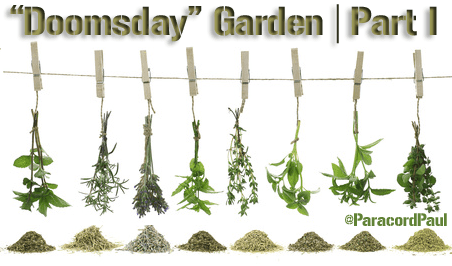Ten Great Medicinal Herbs for Prepping Your “Doomsday” Garden (Part I)

This article is the first in a two-part series on Medicinal Herbs.
Herbal Medicine
Modern medicine has tried to ridicule it, but the truth is that herbal medicine has always been around. The natural cycle has only been altered because of modern man.
However, many countries still use herbal medicine in many parts of the world, and if something catastrophic were to happen, we’d be on our own for medical supplies just like those countries. So, starting an herbal garden is a fantastic idea when prepping for a world-altering disaster.
You never know when that day will come, and we’d all be cut off from medical care. It would help if you started by developing an herbal library; this will help you learn what each herb and herb combination can do.
There are a lot of terrific books about herbal medicine out there. But there’s one that tops them all and is thought to be the bible of herbs. So, if you decide to buy two or three herbal medicine books, this book, PDR for Herbal Medicines, 4th Edition, is essential to add to your collection. It has current research on every herb, folk remedy effects, scientifically documented effects, and prescription drug interactions.
It’s impossible to create a complete list of every effective herb you need to grow, but this is a partial list of the top must-have medicinal herbs that could be grown in almost any garden. The other half of the list will follow in my next post.
Aloe Vera
This plant is beneficial for treating you internally as well as externally.
For external treatment, the gel is well-known for soothing the damaged skin caused by burns, like sunburns, rubbing aloe on the affected skin, and minimizing the chance of blistering. However, it’s also great for minor skin infections, acne, treating cuts, eczema, itching, hair loss, dry skin, arthritis, insect bites, and fungal infections.
You can also drink the aloe vera juice. But be warned, the juice is quite bitter, so you’ll want to mix it with something to hide the taste. Drinking aloe vera juice helps with digestion and is a good laxative.
However, drink only a small amount if you have to use it as a laxative because some people could experience bad cramping. It’s also said to be good for ulcers, strengthens the immune system, colitis, diabetes, and irritable bowel syndrome (IBS), and is an aid in managing cancer.
Cayenne Pepper
This is an excellent source of Vitamin C and a popular chili spice, and Cayenne Pepper has many medicinal uses.
If applied topically, it relieves headaches and eases toothaches on a short-term basis, and it’s a good aid for arthritis and rheumatism.
Adding cayenne pepper to tea helps relieve congestion that comes with a cold and can alleviate symptoms caused by the flu. You can gargle with it if you have a sore throat; it’s a powerful blood flow stimulant and, when mixed with parsley and garlic, helps lower blood pressure.
Cayenne pepper is also very effective in repelling heart attacks. In addition, it helps to reduce asthma symptoms and assists with digestion problems like gas, stomach aches, and cramps; it can be utilized as a control for external and internal bleeding.
Chamomile
We’re all familiar with chamomile tea and how chamomile can aid in better sleep. But did you know that it has other uses?
It’s also used topically as a paste for rashes, ulcers, burns, and infections. It can be applied as an oil and helps treat eczema and neuralgia. If, after a catastrophic situation, you’re lucky enough to gather enough water for a bath, you can hang some chamomile flowers in a mesh bag on the tap and let the water run over the bag. Chamomile added to your bath water will assist in alleviating the pain of cystitis and hemorrhoids.
Used as a tea, chamomile can help various symptoms such as gas, menstrual cramps, diarrhea, morning sickness, stomach cramps, fever, headaches, indigestion, colds, vomiting, poor digestion, nausea, nervousness, congestion, and stress. Chamomile can also be used as a warm compress for eye and ear problems. For babies, it’s excellent for teething pain and colic.
Chamomile flowers can be inhaled as steam, which will help with asthma, respiratory problems, sinusitis, and hay fever.
Dandelion
Did you ever imagine that the dreaded lawn weed could benefit you? Well, it is.
It’s incredibly high in Vitamin C and Vitamin A, and while some people put it in salads, there are various things that this weed is good for.
You can make the dandelion root into tea or coffee or mix it with warm milk and a bit of sweetener, and it’s very safe for you to drink and enjoy — like a coffee, you can have as much as you want and not have to worry about caffeine. As a tea, it’s known to improve the pancreas, liver, stomach, gallbladder, intestines, and spleen, reduce inflammation of cirrhosis and hepatitis, and enhance bile flow.
Dandelion tea also assists with gastric disorders, indigestion, constipation, blood cleansing, basic fatigue, and sluggishness. In addition, it regulates blood sugar levels and deals with the discomfort of digestive disorders.
The white sap from the roots or stems of the dandelion may be put right on the skin to ease the discomfort of bee stings and sores; it can eliminate acne, warts, and calluses and alleviate the signs of gout.
Echinacea
Echinacea is one powerful herb. It assists in strengthening the immune system, thus allowing you to fight better against sore throats, colds, bronchitis, and flu. Plus, it helps clear mucus from the respiratory tract for specific conditions, is a potent anti-inflammatory, and treats urinary tract infections.
When used topically, this is also great for wounds and is utilized to alleviate arthritis pain.
Now, you have a terrific start for the herbs you’ll need for your garden. You can find Part II here.








